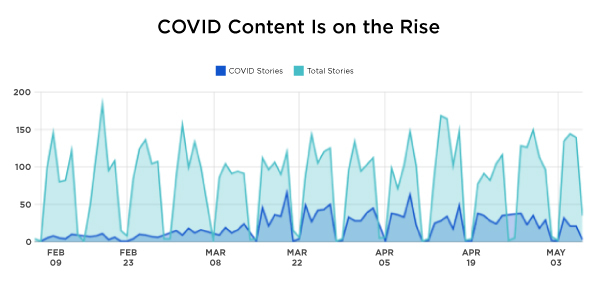Storytelling
How Healthcare Brands Can Publish Timely COVID Content That Audiences Need
Last updated: February 6, 2022
A global pandemic impacts everyone and everything. As cases started to spike, it wasn’t long before it seemed like every article, video, and social post tied back to the coronavirus.
For many companies, especially in healthcare, covering the topic was vital. They had an obligation to share their knowledge with the public. For others, though, it was just another trending topic to jump on. Even if it comes from a good place, we don’t need an email from a car dealership that says they’re “here for us during these troubling times.”
To gauge the immediate impact on content creation, we pulled the stories created by Contently clients across all industries and then tagged any that mentioned relevant terms like “pandemic,” “Covid,” and “quarantine.” In March, content related to the coronavirus accounted for 21 percent of all stories across all industries, a significant increase up from roughly 6 percent in February 2020. The rate held steady through April until dipping slightly in May. 2020

The surge in new content proved to be an interesting case study for healthcare publishers. There’s an overabundance of health content online, but it mostly consists of evergreen information on established domains like WebMD and Livestrong. These sites live off of consistent search traffic, but they typically don’t connect to the news cycle. Once the coronavirus hit, that all changed.
Since great storytelling thrives on specifics, other brands had a new opportunity to create timely content. Some of the top-performing stories in our dataset came from companies putting a unique spin on the public conversation.
For example, in late March 2020, Cleveland Clinic published “Here’s the Damage Coronavirus Can Do to Your Lungs” with expert quotes and a link to a new video featuring an experienced lung pathologist. It was shared over 26,000 times on Facebook. Cigna ran an early how-to story on proper handwashing technique that generated thousands of shares. Shortly after, 23andMe wrote about a research study it was working on to look at the connection between genetics and COVID-19.

If healthcare companies hope to compete with the WebMDs of the world, they have to drive awareness first with these kinds of original stories. Then, once they build trust and increase domain authority, they can fill in their output with more clinical, encyclopedic content.
However, that doesn’t mean healthcare brands should start pursuing journalistic COVID content. These stories lead to conflicts of interest. Plus, brands usually don’t have the resources or infrastructure in place to go after hard news. However, they can break new ground and build an audience simply by reporting on the research and innovations being developed inside their own company.
“In the health category, there’s no such thing as a generalist … think about what your audience is searching for,” said Amy O’Connor, editor-in-chief of Healthination. “Unless you’re like AP or Reuters, it’s really hard to cover the news, and nobody wants you to, because it’s already out there.”
Your time and money would be better spent using trending topics as a springboard to provide insights and analysis the public can’t get anywhere else.
This is an excerpt from our report: The State of Healthcare Content Marketing. Click here to read the full report for free (there’s no form to fill out or file to download.)
Image by ZubadaGet better at your job right now.
Read our monthly newsletter to master content marketing. It’s made for marketers, creators, and everyone in between.




